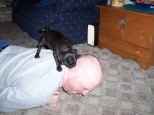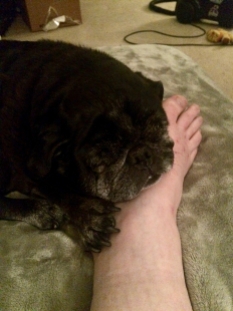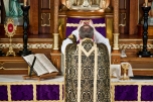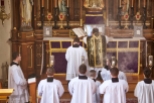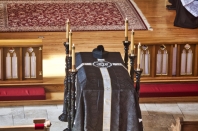By Joseph Hanneman
Racine Journal Times
A group of sparrows perched on the edge of the bird feeder outside Lloyd Miller’s window, pecking at the seeds like there was no tomorrow.
Oblivious to the man watching them from just feet away, the birds went about their business, then flew away. They are a living reminder of just how much Miller’s life has changed in the past four years.

For much of his life, the 71-year-old Miller never had time for little hobbies like bird watching. From his early days as a cavalry instructor in the U.S. Army to his career as a salesman and Racine’s city development director, Miller was a busy man.
Then came cancer.
“I never had a bird feeder before. Now, I’m feeding the birds at $10 a week,” Miller says with a chuckle. “I’ll have to win the lottery.”
Aside from the pinkish patch of scar tissue on his head and his lack of hair, you would never know this man tangled with a rare, life-threatening cancer.
He has a firm handshake, a hearty belly laugh and a warmth that twinkles from beneath his spectacles.
Life has changed
The bird feeder is one of the little ways Miller is a different man now. He isn’t bothered by the little things anymore. He’s more tolerant. He finds it a lot easier to tell his wife and friends that he loves them.
And although life has brought him persistent heart problems and a cancer that came back four times, Miller considers himself lucky.

“I do not consider myself dying of cancer,” he says, softly tracing an invisible pattern on the kitchen table with his index finger, “but living despite it. I do not look at each day as a day closer to death, but another day to be appreciated and enjoyed.”
Lloyd Miller is a cancer survivor.
He is one of the 50 percent of cancer patients who live through the terrifying diagnosis, the fear, the uncertainty, the sickening treatments and the real risk of death. He is part of a growing group with a determination to live life fully, with a new appreciation for what was almost lost.
Miller’s rare form of cancer is in remission, four years after it was discovered. And although there still is a risk the cancer could come back and attack his lungs, he doesn’t let it worry him.
“I feel so comfortable, it’s almost a sin. I don’t think about it every day.”
But for much of the past few years, Miller had little choice but to think about cancer.
The first inkling of trouble came in 1987 while he was on a cruise with Sue, his wife of 16 years. A sunburn-like patch of blisters appeared on the left side of his scalp. It didn’t concern him, until his eye began to swell so badly he had to soak it to get it to open. Upon returning to Racine from Miami, Miller went to see his doctor in Kenosha. The doctor took a biopsy, then delivered the kind of heart-stopping news everyone fears.

“I knew I was in trouble. I expected bad news. It was bad news. Believe it or not, I was afraid,” he said. “The word ‘cancer’ just sent chills through me.”
The doctor referred Miller to the University of Wisconsin Comprehensive Cancer Center in Madison, one of the nation’s major cancer centers, with a medical staff of 350.
Doctors took 60 biopsies from Miller’s scalp in an effort to find what kind of cancer had taken hold.
Rare cancer diagnosed
The diagnosis was angiosarcoma, a rare cancer of the blood vessels that spreads to the connective tissues. Miller had extensive tumors throughout the left side of his scalp.
Doctors started Miller on a regimen of radiation treatments using a high-tech system in which treatments are planned using 3-D computers that help aim the radiation most effectively at the cancer. He traveled to the UW daily for treatments — journeys that would eventually total 33,000 miles.
The hospital staff drew targets with ink on his now-bald head. They took measurements and calibrated the 6-million-volt radiation machine.
The treatments were terrifying for Miller. Much of his head was covered in a lead mask that shielded healthy tissue. For a man with severe claustrophobia, the enclosure was pure hell.
“I would have killed them if I could have gotten loose,” he said. “When I got out of there, I said, ‘Never again, not me. I’ll die.’ ”
For his next trip, doctors gave Miller what he called “goofy pills” that helped him relax so much before treatment that by the time he arrived in Madison, he didn’t care what happened.
Treatments burn the scalp
The 30 treatments burned Miller’s scalp, causing an unsightly, migrating sore that covered a quarter of his scalp before it started to recede. But the therapy worked and the tumors died off.
Miller said death crossed his mind during those first days in treatment.
But his main physician, Dr. Timothy Kinsella, deputy director of the cancer center, told Miller to let him worry about the cancer.
“I’ll tell you when to worry,” Kinsella said. Those six words put Miller at ease. Kinsella never told Miller to worry.
“He was the Good Hands doctor,” Miller said, cupping his hands like they do on the Allstate insurance commercials. “He made me understand I was going to be all right.”
Despite the daily doses of radiation, Miller kept up his work schedule.
Staying on the job was important because, as Miller put it, “If a guy lies down in bed, I think he’s a goner.”
Shortly after the first round of radiation, doctors discovered nodes on the right side of Miller’s head. The cancer was back, which meant 30 more visits to the linear accelerator.
Eventually, the cancer spread to both sides of Millers’ neck and on the center of his head. Each time it appeared, Kinsella beat it back with radiation.
Miller became quite a regular on the first-floor clinic at the cancer center. He made the coffee in the waiting room, and brought Racine kringle for the staff. When he wasn’t in treatment, he spent time in the pediatric cancer ward.
One day, Miller was charged with cheering up a young boy who was quite sick from his cancer treatments. Miller pulled out a toy ball that laughed with the resonance of Ed McMahon when it was tossed into the air. “That was my secret weapon,” Miller said. “He liked it so much I gave it to him.”
They still remember Lloyd Miller at UW Cancer Center.
Help and prayers
And so Miller has beaten the odds, it would seem. It’s only now that one of his local doctors told him that after the initial cancer diagnosis, he wasn’t sure Miller would survive.
Now he spends time as a freelance real estate development consultant and likes to play golf at the Kenosha country club. Miller says he got through his ordeal with cancer with a lot of help from scores of friends and a lot of prayer.
“I think I’m a better man now than I ever was,” he said. “I’ve come so close to the unknown.”
His health has not been without complications since the cancer therapy stopped. He recently underwent his 11th balloon angioplasty, a procedure in which a tiny balloon is inflated in the arteries to clear blockages.
Miller’s story caught the attention of the American Cancer Society, which profiled him in an hourlong documentary on cancer survivors in 1990. The program also featured a 23-year-old student who lost his leg to cancer, then ran across country to raise money for cancer research.
Tears well up in Miller’s eyes when he watches the tape, as he watches his wife describe him as “our hero, Lloyd,” and as he watches himself talk about cancer.
“An experience like this lets you know what life’s all about,” he said. •
EPILOGUE: Lloyd G. Miller died on March 6, 2004 at his retirement home in Orlando, Fla. He was 83.




















